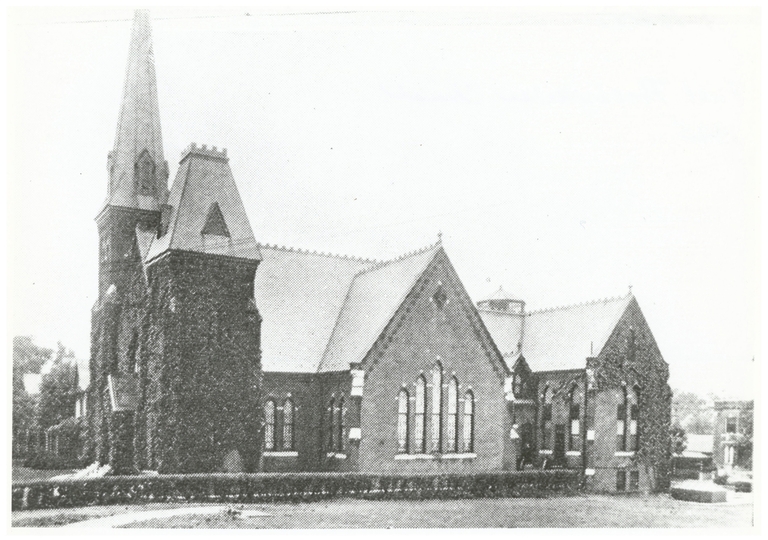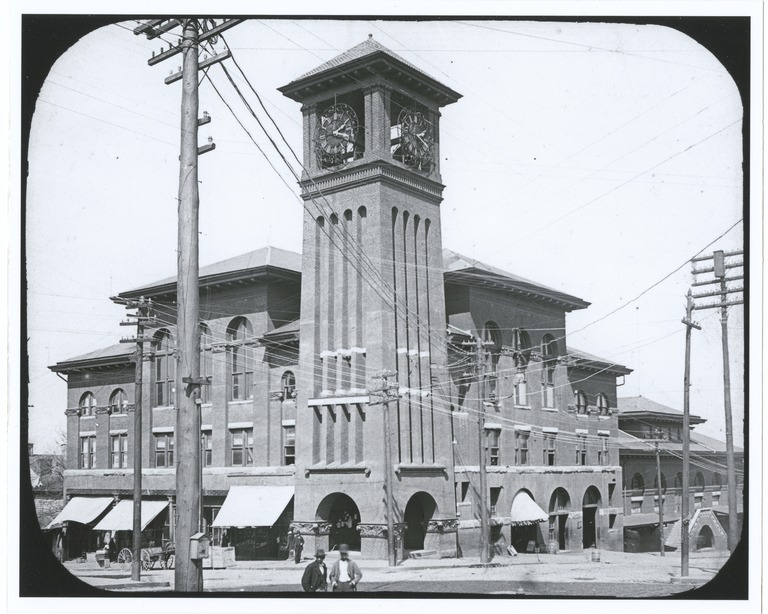Miller Brothers (1870s-1880s)
Variant Name(s):
John Sylvester Miller; Gideon Leander Miller
Founded:
Forsyth County, North Carolina, USA
Residences:
- Winston-Salem, North Carolina
Trades:
- Contractor
NC Work Locations:
Building Types:
Styles & Forms:
Gothic Revival; Italianate
Along with the larger and longer-lived Fogle Brothers firm, the Miller Brothers—Gideon Leander Miller (1845-1907) and John Sylvester Miller (1839-1894)—constructed a substantial proportion of Winston-Salem’s tobacco factories, warehouses, dwellings, tenements, and civic and commercial structures that rose from the 1870s to the end of the century. Built before the two towns of Winston and Salem merged as Winston-Salem in 1913, their work was part of an important generation of robust and eclectic local architecture, much of which was destroyed as the city boomed and rebuilt in the 20th century. The principal surviving example of their extensive body of work is the ornate James and Mary Rogers House on Cherry Street.
During the last third of the nineteenth century, the old Moravian town of Salem and especially the newer, nearby county seat of Winston expanded their industrial pursuits, and Winston, especially, experienced rapid population and economic growth in the 1870s and 1880s. This burst of growth laid the foundation for the joining of the “twin cities” in 1913 and Winston-Salem’s emergence as the wealthiest city in the state in the 20th century.
Gideon and John Miller were poised to contribute to this late 19th century growth. Natives of the area, they were sons of John Sylvester Miller Sr., a Forsyth County farmer, and his wife Elizabeth Miller of Salem. As noted by Heather Fearnbach in Winston-Salem’s Architectural Heritage, Gideon Miller and John Miller (Jr.) had worked for the Fogle Brothers for a time before they established their Miller Brothers contracting firm in 1872. Initially, they purchased building materials from the Fogle Brothers, but in 1877 they established their own planing mill and lumber yard. In 1880 the census noted Gideon as a contractor and John as owner of a lumber business. In 1882 Moravian bishop Edward Rondthaler remarked on the growth of Salem and Winston and commented on the important role of “the building operations of Messrs. Fogle and Messrs. Miller which have to a great extent built the newer parts of both places; and by the successful business undertakings of Salem people across the almost imaginary line dividing the two places.” At that point, the twin cities’ expansion had only begun.
John Miller retired in 1884. After a fire destroyed the firm’s initial planing mill, located on West First Street between Chestnut and Depot Streets, Gideon replaced it with a brick complex. The operation produced windows, sash, blinds, doors, and other woodwork. The company contracted for numerous buildings in the 1880s and early 1890s, and in response to the economic crisis of 1893 added furniture manufacturing as the Winston Furniture Factory.
The Miller Brothers, like the Fogle Brothers, constructed the full range of building types the growing city needed. Fearnbach cites Presbyterian and Methodist churches, the 1889 Roanoke and Southern Railroad Company Depot, the Depot Street Graded School, a R. J. Reynolds Tobacco Company Factory, the Gray Block, the James Alexander and Aurelia Bowman Gray House, and the Payne, Lunn, and Morris Tobacco Factory. Especially prominent was the Winston Town Hall (1891-1893), a large brick building in Romanesque Revival style with a massive, tapered corner tower, designed by architects Glenn Brown and Willis E. Hall and built by the Miller Brothers on a bid of $45,000 ( Manufacturers’ Record, August 15, 1891).
During the 1880s and 1890s, several wealthy families built large and fashionable residences on what was then the outskirts of Winston, including a notable cluster on Cherry Street between First and Fifth Streets. Both the Miller Brothers and the Fogle Brothers constructed these prestigious residences. The James and Mary Rogers House (1883-1885), built for prominent businessman James Mitchell Rogers of South Carolina and his wife Mary Erwin of Morganton, is evidently the only standing work by the Miller Brothers. Combining Gothic Revival, Italianate, and Stick Style motifs, it is a rare survivor of Winston-Salem’s once numerous Victorian mansions and ebullient late 19th century architecture.
Depot Street Graded School
Contributors:Miller Brothers, contractorsDates:1887
Location:Winston-Salem, Forsyth CountyStreet Address:Depot St., Winston-Salem, NC
Status:No longer standing
Type:Educational
Note:The 2-story frame school stood in an area that was a hub of the city’s black community life. It was opened for classes in 1887 and was the first public school for African American students in Winston-Salem. It has been described as the largest and most important public school for African Americans in North Carolina in its day.
First Presbyterian Church
Contributors:Miller Brothers, contractorsDates:1888
Location:Winston-Salem, Forsyth CountyStreet Address:300 N. Cherry St., Winston-Salem, NC
Status:No longer standing
Type:Religious
Images Published In:Heather Fearnbach, Winston-Salem’s Architectural Heritage (2015).
James and Mary Rogers House
Contributors:Miller Brothers, contractorsVariant Name(s):James Mitchell Rogers House
Dates:1883-1885
Location:Winston-Salem, Forsyth CountyStreet Address:102 S. Cherry St., Winston-Salem, NC
Status:Standing
Type:Residential
Images Published In:Heather Fearnbach, Winston-Salem’s Architectural Heritage (2015).
Winston Town Hall
Contributors:Glenn Brown, architect; Willis E. Hall, architect; Miller Brothers, contractorsVariant Name(s):Winston City Hall; Winston-Salem City Hall
Dates:1892-1893
Location:Winston-Salem, Forsyth CountyStreet Address:4th St. and Main St., Winston-Salem, NC
Status:No longer standing
Type:Public
Images Published In:Molly Grogan Rawls, Winston-Salem in Vintage Postcards (2004).


